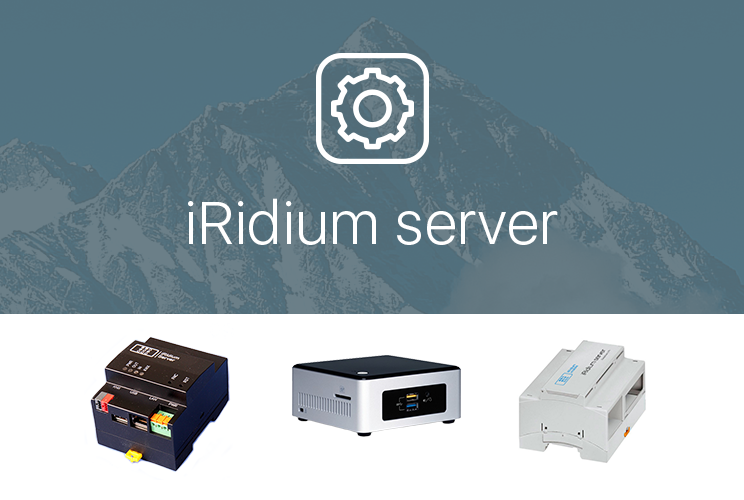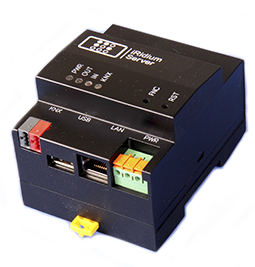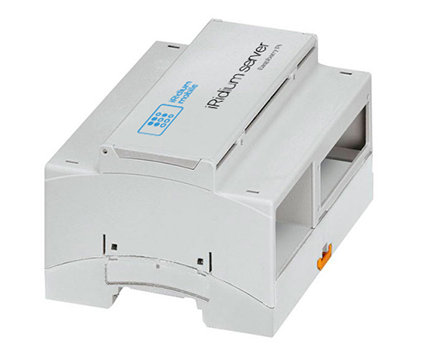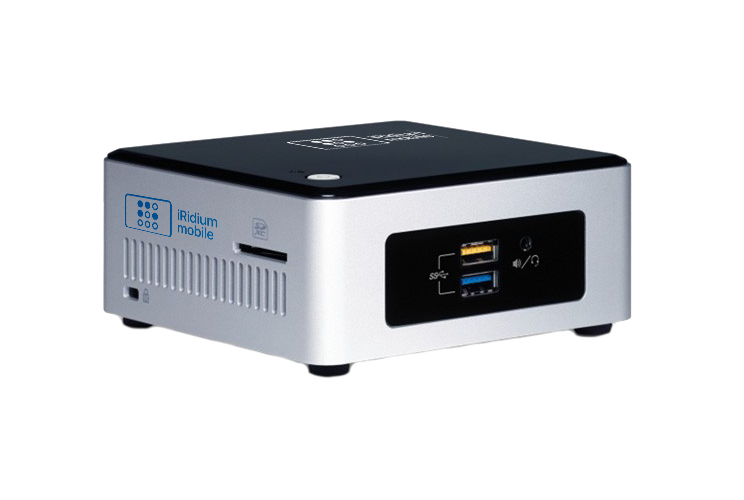Choosing an iRidium server for a smart home: hardware controllers
Historically, our product complemented iOS / Android / Windows with visualization of a nearly completed automation system, it was the “cherry on the cake” that sold the product and pleased the customer. But a couple of years ago we released version 3 with the ability to add a freely programmable controller to the systems , and it began to enjoy unexpected success. Our company is engaged in software development and at first the choice of the iron part did not seem to be a problem to us - take the controller, put Linux or Windows on it, here, let it work.

But the professional automation market doesn’t work at all; a ready-made software and hardware solution is in principle important here. In support of the poured appeal and with this it was necessary to do something. It was clear that we needed a finished product, but to do a completely own controller meant to spend a lot of money / time and doom yourself to competition from constantly updated mass products - Raspberry Pi, Intel platforms, and so on. On the other hand, without a good professional controller, many large objects were closed for us. And that's how we solved this issue.
Why do we need a controller in professional installations? There are saved schedules and logic of complex interaction, sometimes virtual thermostats and the like. It happens, is used for remote access and as a gateway between protocols. It is imperative that such a controller is not necessary for the functioning of the system; ordinary automation tasks should work without it. How our server solution works can be viewed in Katya Korezhatkova’s webinar.
')
And here, for example, how to set up schedules and rules through the editor:
iRidium UMC
We began by finding a manufacturing partner and jointly developing a UMC controller. Black, powerful, and with KNX on board, initially focused on future exports, because the European integrators of this protocol were rapidly moving to the first place in purchasing licenses.
Suitable for typical KNX installations: private houses up to 1500 sq.m. and building lighting control systems.
1GHz CPU FreeScale imx6 processor
RAM 512 MB
Nonvolatile memory (executable code and data) 1GB + 4GB microSD
Model "UMC-C2": on board KNX TP1-256, LAN, USB A

Its main tasks are to complement KNX projects with free logic, serve as a gateway to other protocols (Modbus TCP, BACnet, MQTT, HTTP, etc.), local IoT controller of platforms (IBM Bluemix, ThingWorks, Thingspeak, Wire Geo, etc.), device access for remote control via iRidium. It also works as a KNX interface, it can be used to program devices via ETS ( video ).
The controller itself cannot be called cheap, but we decided to make a special type of licensing for it, opening up interesting possibilities.
So for UMC we made a special version of this license and the controller together with it for the end user will cost 105,000 rubles . The controller itself works fine with installations of up to 10,000 datapoints (of which up to 1,000 are in the SQL database) and 100th visualization panels at the same time. A couple of weeks ago I received European certification.
iRidium RPi
Relatively expensive option we did, it was the turn of cheap. And here, no matter how much we choose the platform, it was either more expensive or weaker than the Raspberry Pi. Yes, they are for prototyping, not for the mass market. Yes, there is no electrostatic protection. Yes, the operating system on the SD card. But it is used very widely and shows itself very well.
In the end, we gave up and stopped at this. The iRidium RPi controller is based on the 3rd model, comes in a DIN package with 8 modules. The kit includes a power supply and installed / configured iRidium server. We recommend selling it to end users for 9000 rubles.

Such a controller is suitable for apartments and houses up to 500 sq.m., if the client does not need to maintain a database of system values (for example, it is maintained in the cloud). Here we recommend no more than 5,000 tags, of which no more than 500 are with an entry in the SQL database. And also up to 100 client panels.
iRidium NUC
For the third option chose the platform Intel NUC. It is reliable enough for Intel to recommend it as part of its IoT platform and is quite affordable. This option is the most correct, if you need a place for SQL database, there is a 60 GB drive installed.

iRidium NUC is the most powerful of the currently available ready-made controllers. It works without problems with datapoints of up to 15,000 pieces, but it is better to record no more than 2000 in the database of them. It is also the fastest in terms of working with scripts. The recommended price for end users is 30 thousand rubles.
Such a controller is suitable for any type of object, from an apartment to a small building, if you need good logic and data storage for a long period of time.
And here is a small summary table of power:

Other configurations
These are ready configurations of controllers that we assemble ourselves for those who are more comfortable. All of them work on Linux and are delivered customized, you only need to activate.
Of course, the old model remains where you can build any configuration for yourself, install Linux or Windows. For example, we collected NUC on Intel Core i7 for ourselves and could not even download our tests so that we could understand the limitations.
There are also models of third-party controllers that successfully work with the iRidium server on board. A typical example is WirenBoard. We tested the WirenBoard 0 version, specially created for iRidium projects, as well as the 5th version. There is a simple way to install a special assembly, they can communicate with the internal functions of the controller via the MQTT protocol.
This controller is good, but simple. We recommend that you do not use a database entry on it, no more than 1,000 datapointments in total and no more than 20 client panels. WirenBoard 6 will be more powerful, test it right now.
Now it seems to us that we have a fairly simple and balanced line of controllers. Once every few months we will update and update it. More information, as usual, on the website and in the documentation .

But the professional automation market doesn’t work at all; a ready-made software and hardware solution is in principle important here. In support of the poured appeal and with this it was necessary to do something. It was clear that we needed a finished product, but to do a completely own controller meant to spend a lot of money / time and doom yourself to competition from constantly updated mass products - Raspberry Pi, Intel platforms, and so on. On the other hand, without a good professional controller, many large objects were closed for us. And that's how we solved this issue.
Why do we need a controller in professional installations? There are saved schedules and logic of complex interaction, sometimes virtual thermostats and the like. It happens, is used for remote access and as a gateway between protocols. It is imperative that such a controller is not necessary for the functioning of the system; ordinary automation tasks should work without it. How our server solution works can be viewed in Katya Korezhatkova’s webinar.
')
And here, for example, how to set up schedules and rules through the editor:
iRidium UMC
We began by finding a manufacturing partner and jointly developing a UMC controller. Black, powerful, and with KNX on board, initially focused on future exports, because the European integrators of this protocol were rapidly moving to the first place in purchasing licenses.
Suitable for typical KNX installations: private houses up to 1500 sq.m. and building lighting control systems.
1GHz CPU FreeScale imx6 processor
RAM 512 MB
Nonvolatile memory (executable code and data) 1GB + 4GB microSD
Model "UMC-C2": on board KNX TP1-256, LAN, USB A

Its main tasks are to complement KNX projects with free logic, serve as a gateway to other protocols (Modbus TCP, BACnet, MQTT, HTTP, etc.), local IoT controller of platforms (IBM Bluemix, ThingWorks, Thingspeak, Wire Geo, etc.), device access for remote control via iRidium. It also works as a KNX interface, it can be used to program devices via ETS ( video ).
The controller itself cannot be called cheap, but we decided to make a special type of licensing for it, opening up interesting possibilities.
Help on iRidium prices. In general, we have free licenses for controllers, up to 50 datpoint. IRidium minimum commercial licenses start from about 9 thousand rubles (Starter for AV), but there are also much more advanced options. The most expensive possible license assumes that you will have an unlimited number of control panels, all protocols and up to (conditionally) 10,000 datpoint to receive information, it is usually used immediately to the whole building or even a complex of buildings. Such a license is worth 562 thousand rubles and from the experience of sales we have seen that this is a reasonable price for such a decision.
So for UMC we made a special version of this license and the controller together with it for the end user will cost 105,000 rubles . The controller itself works fine with installations of up to 10,000 datapoints (of which up to 1,000 are in the SQL database) and 100th visualization panels at the same time. A couple of weeks ago I received European certification.
iRidium RPi
Relatively expensive option we did, it was the turn of cheap. And here, no matter how much we choose the platform, it was either more expensive or weaker than the Raspberry Pi. Yes, they are for prototyping, not for the mass market. Yes, there is no electrostatic protection. Yes, the operating system on the SD card. But it is used very widely and shows itself very well.
In the end, we gave up and stopped at this. The iRidium RPi controller is based on the 3rd model, comes in a DIN package with 8 modules. The kit includes a power supply and installed / configured iRidium server. We recommend selling it to end users for 9000 rubles.

Such a controller is suitable for apartments and houses up to 500 sq.m., if the client does not need to maintain a database of system values (for example, it is maintained in the cloud). Here we recommend no more than 5,000 tags, of which no more than 500 are with an entry in the SQL database. And also up to 100 client panels.
iRidium NUC
For the third option chose the platform Intel NUC. It is reliable enough for Intel to recommend it as part of its IoT platform and is quite affordable. This option is the most correct, if you need a place for SQL database, there is a 60 GB drive installed.

iRidium NUC is the most powerful of the currently available ready-made controllers. It works without problems with datapoints of up to 15,000 pieces, but it is better to record no more than 2000 in the database of them. It is also the fastest in terms of working with scripts. The recommended price for end users is 30 thousand rubles.
Such a controller is suitable for any type of object, from an apartment to a small building, if you need good logic and data storage for a long period of time.
And here is a small summary table of power:

Other configurations
These are ready configurations of controllers that we assemble ourselves for those who are more comfortable. All of them work on Linux and are delivered customized, you only need to activate.
Of course, the old model remains where you can build any configuration for yourself, install Linux or Windows. For example, we collected NUC on Intel Core i7 for ourselves and could not even download our tests so that we could understand the limitations.
There are also models of third-party controllers that successfully work with the iRidium server on board. A typical example is WirenBoard. We tested the WirenBoard 0 version, specially created for iRidium projects, as well as the 5th version. There is a simple way to install a special assembly, they can communicate with the internal functions of the controller via the MQTT protocol.
This controller is good, but simple. We recommend that you do not use a database entry on it, no more than 1,000 datapointments in total and no more than 20 client panels. WirenBoard 6 will be more powerful, test it right now.
Now it seems to us that we have a fairly simple and balanced line of controllers. Once every few months we will update and update it. More information, as usual, on the website and in the documentation .
Source: https://habr.com/ru/post/370535/
All Articles